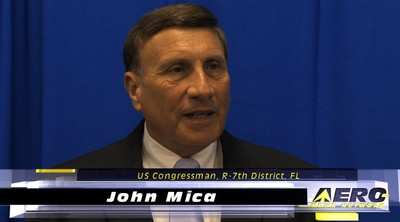Compromise Bill Passed By Conference Committee ... Next Stop
The Full House And Senate
A conference committee made up of House and Senate leaders on
Tuesday reached agreement on long-term FAA legislation to improve
the nation’s aviation infrastructure, modernize our air
traffic control system, and reform FAA programs.

“After a five-year delay and 23 temporary extensions, this
measure is key to advancing the nearly eight percent of our
nation’s economy impacted by the aviation industry,”
said Transportation and Infrastructure Committee Chairman John L.
Mica (R-FL). “This bipartisan, bicameral agreement ensures
long-term aviation safety and infrastructure funding for the next
four years. I commend my colleagues in the House and Senate for
working across party lines to come together on this long overdue
measure to make needed reforms at FAA, fund programs for
constructing major airport infrastructure improvements, and help
create jobs for Americans.”
“This legislation will, at long last, provide stable funding
and policy direction for the FAA’s safety programs, airport
development grants, and operations for fiscal years 2012 through
2015,” said Aviation Subcommittee Chairman Tom Petri (R-WI).
“I am particularly pleased that we are moving forward with
the ‘NextGen’ modernization of our air traffic control
system. Once in place, the new system will bring about a revolution
in aviation providing greater safety, lower costs, fewer emissions
and better on-time performance with shorter, more direct flights. I
am very excited about it.”
House and Senate conferees convened this afternoon to discuss the
compromise on the differing multi-year FAA reauthorization bills
passed by each body last year. The measure, expected to be voted on
by the full House and Senate before the current short-term funding
extension expires on February 17th, includes the following
highlights:
- Funds safety programs, NextGen air traffic control
modernization, and FAA operations through FY 2015.
- Creates and supports jobs by providing stable funding for
airport improvements under the Airport Improvement Program.
- Provides in total approximately $13.4 billion for the Airport
Improvement Program, $38.3 billion for FAA Operations, $672 million
for Research, Engineering & Development, and $10.9 billion for
FAA’s Facilities & Equipment account.
- Stimulates private sector job creation in the unmanned aircraft
systems industry by setting timelines for FAA action on the safe
integration of UASs into the national airspace system.
- Accelerates deployment of NextGen technologies that will bring
significant benefits to the overall U.S. economy – everybody,
not just aviation users, benefits from NextGen.
- Strengthen accountability for the progress on the NextGen
program.
- Streamlines environmental reviews for new, more efficient
flight paths.
- Includes labor reforms of the National Mediation Board
(NMB).
- Limits efforts to over-regulate the lithium battery
industry.
- Eliminates some subsidies within the Essential Air Service
(EAS) program.
- Sets a balanced inspection regime for airliners that are
inspected overseas.
- Establishes the process for consolidation of outdated FAA air
traffic control facilities.
- Enacts passenger protections to be sure airline passengers are
treated fairly when travelling.
"This conference is the culmination of a lot of hard work by my
House and Senate colleagues," said Senator John D. "Jay"
Rockefeller IV (D-WV), Chair of the Senate Transportation
Committee. "We’re in the final stage of signing off on a
conference report that I hope will go to the floor for House and
Senate passage. This bill is years overdue. But getting it signed
into law will make aviation safer, create jobs, and make sure that
small communities have access to critical air service. It will make
sure the FAA continues to set the gold standard for safety
oversight and the U.S. aviation industry remains competitive and
strong.”
Senators Rockefeller (L) and Hutchison
(R)

“No one got everything they thought was important, but I
do believe the way we came together preserved the major things we
needed to do right," added the committee's ranking Republican,
Senator Kay Bailey Hutchison (R-TX). "I am very pleased and I think
the safety improvements and the improvements on the perimeter rule,
which will be significant for the western Senators. I didn’t
have a stake in that, but I really, really related to the people
who were not able to have direct service from National and I think
we came to a good conclusion there.
“Most certainly, I think, the NextGen can’t be done in
six months or one-year extensions. That is a huge technological
advance for our air-traffic control system to meet the standards
for the rest of the world and we need a satellite based system and
we would never be able to get a start on that without having this
four years of stability and knowing it’s going to be an
on-going process that is built in the proper way.
“I also believe the security improvements that we made are
good. I think we will now have opportunities for the private-sector
to be in airport security, but with the TSA having the final say,
as they should, and I think we got a good compromise there."
No date has been set for floor votes on the bill. Some special
interest groups, notably labor unions, still have strong objections
to the measure, and there will likely be some resistance to the
cuts made in the Essential Air Services programs. The current
temporary funding measure expires February 17th.
 Aero-News: Quote of the Day (04.28.25)
Aero-News: Quote of the Day (04.28.25) ANN's Daily Aero-Term (04.28.25): Decision Altitude (DA)
ANN's Daily Aero-Term (04.28.25): Decision Altitude (DA) ANN's Daily Aero-Linx (04.28.25)
ANN's Daily Aero-Linx (04.28.25) Airborne-Flight Training 04.24.25: GA Refocused, Seminole/Epic, WestJet v TFWP
Airborne-Flight Training 04.24.25: GA Refocused, Seminole/Epic, WestJet v TFWP Aero-News: Quote of the Day (04.29.25)
Aero-News: Quote of the Day (04.29.25)




